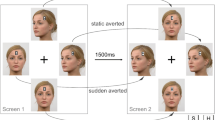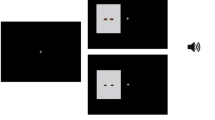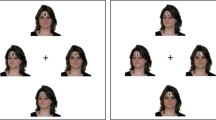Abstract
Eye-tracking was used to investigate whether gaze direction would influence the visual scanning of faces, when presented in the context of a full character, in different social settings, and with different task demands. Participants viewed individual computer agents against either a blank background or a bar scene setting, during both a free-viewing task and an attractiveness rating task for each character. Faces with a direct gaze were viewed longer than faces with an averted gaze regardless of body context, social settings, and task demands. Additionally, participants evaluated characters with a direct gaze as more attractive than characters with an averted gaze. These results, obtained with pictures of computer agents rather than real people, suggest that direct gaze is a powerful attention grabbing stimulus that is robust to background context or task demands.





Similar content being viewed by others
References
Alicke, M. D., Smith, R. H., & Klotz, M. L. (1986). Judgments of physical attractiveness: The role of faces and bodies. Personality and Social Psychology Bulletin, 12, 381–389.
Baron-Cohen, S. (1995). Mindblindness: An essay on autism and theory of mind. Cambridge, MA: MIT Press.
Castelhano, M. S., Wieth, M., & Henderson, M. J. (2007). I see what you see: Eye movements in real-world scenes are affected by perceived direction of gaze. In L. Paletta & E. Rome (Eds.), Attention in cognitive systems: Theories and systems from an interdisciplinary viewpoint (pp. 251–262). Berlin, Germany: Springer.
Conty, L., Tijus, C., Hugueville, L., Coelho, E., & George, N. (2006). Searching for asymmetries in the detection of gaze contact versus averted gaze under different head views: A behavioural study. Spatial Vision, 19, 529–545.
Conway, C. A., Jones, B. C., DeBruine, L. M., & Little, A. C. (2008). Evidence for adaptive design in human gaze preference. Proceedings of the Royal Society of London Series B: Biological Sciences, 275, 63–69.
Currie, T. E., & Little, A. C. (2009). The relative importance of the face and body in judgments of human physical attractiveness. Evolution and Human Behavior, 30, 409–416.
Doi, H., & Ueda, K. (2007). Searching for a perceived stare in the crowd. Perception, 36, 773–780.
Doi, H., Ueda, K., & Shinohara, K. (2009). Neural correlates of the stare-in-the-crowd effect. Neuropsychologia, 47, 1053–1060.
Driver, J., Davis, G., Ricciardelli, P., Kidd, P., Maxwell, E., & Baron-Cohen, S. (1999). Gaze perception triggers reflexive visuospatial orienting. Visual Cognition, 6, 509–540.
Ewing, L., Rhodes, G., & Pellicano, E. (2010). Have you got the look? Gaze direction affects judgements of facial attractiveness. Visual Cognition, 18, 321–330.
Farroni, T., Csibra, G., Simion, F., & Johnson, M. H. (2002). Eye contact detection in humans from birth. Proceedings of the National Academy of Sciences of the United States of America, 99, 9602–9605.
Friesen, C. K., & Kingstone, A. (1998). The eyes have it! Reflexive orienting is triggered by nonpredictive gaze. Psychonomic Bulletin & Review, 5, 490–495.
Frischen, A., Bayliss, A. P., & Tipper, S. P. (2007). Gaze cueing of attention: Visual attention, social cognition, and individual differences. Psychological Bulletin, 133, 694–724.
Furnham, A., & Reeves, E. (2006). The relative influence of facial neoteny and waist-to-hip ratio on judgements of female attractiveness and fecundity. Psychology, Health & Medicine, 11, 129–141.
Henderson, J. M. (2006). Eye movements. In C. Senior, T. Russell, & M. S. Gazzaniga (Eds.), Methods in mind (pp. 171–191). Cambridge, MA: MIT Press.
Hewig, J., Trippe, R. H., Hecht, H., Straube, T., & Miltner, W. H. R. (2008). Gender differences for specific body regions when looking at men and women. Journal of Nonverbal Behavior, 32, 67–78.
Itier, R. J., & Batty, M. (2009). Neural bases of eye and gaze processing: The core of social cognition. Neuroscience and Biobehavioural Reviews, 33, 843–863.
Itier, R. J., Villate, C., & Ryan, J. D. (2007). Eyes always attract attention but gaze orienting is task-dependent: Evidence from eye movement monitoring. Neuropsychologia, 45, 1019–1028.
Jones, B. C., DeBruine, L. M., Main, J. C., Little, A. C., Welling, L. L. M., Feinberg, D. R., et al. (2010a). Facial cues of dominance modulate the short-term gaze-cuing effect in human observers. Proceedings of the Royal Society of London B, 277, 617–624.
Jones, B. C., Main, J. C., DeBruine, L. M., Little, A. C., & Welling, L. L. M. (2010b). Reading the look of love: Dimorphic cues in opposite-sex faces influence gaze categorization. Psychological Science, 21, 796–798.
Kampe, K. K., Frith, C. D., Dolan, R. J., & Frith, U. (2001). Reward value of attractiveness and gaze. Nature, 413, 589.
Kleinke, C. L. (1986). Gaze and eye contact: A research review. Psychological Bulletin, 100, 78–100.
Langton, S. R., & Bruce, V. (1999). Reflexive visual orienting in response to the social attention of others. Visual Cognition, 6, 541–567.
Main, J. C., DeBruine, L. M., Little, A. C., & Jones, B. C. (2010). Interactions among the effects of head orientation, emotional expression and physical attractiveness on face preferences. Perception, 39, 62–71.
Mojzisch, A., Schilbach, L., Helmert, J. R., Pannasch, S., Velichkovsky, B. M., & Vogeley, K. (2006). The effects of self-involvement on attention, arousal, and facial expression during social interaction with virtual others: A psychophysiological study. Social Neuroscience, 1, 184–195.
Mueser, K. T., Grau, B. W., Sussman, M. S., & Rosen, A. J. (1984). You’re only as pretty as you feel: Facial expression as a determinant of physical attractiveness. Journal of Personality and Social Psychology, 46, 469–478.
Palanica, A., & Itier, R. J. (2011). Searching for a perceived gaze direction using eye tracking. Journal of Vision, 11, 1–13.
Palermo, R., & Rhodes, G. (2007). Are you always on my mind? A review of how face perception and attention interact. Neuropsychologia, 45, 75–92.
Peters, M., Rhodes, G., & Simmons, L. W. (2007). Contributions of the face and body to overall attractiveness. Animal Behaviour, 73, 937–942.
Ricciardelli, P., Betta, E., Pruner, S., & Turatto, M. (2009). Is there a direct link between gaze perception and joint attention behaviours? Effects of gaze contrast polarity on oculomotor behaviour. Experimental Brain Research, 194, 347–357.
Senju, A., & Hasegawa, T. (2005). Direct gaze captures visuospatial attention. Visual Cognition, 12, 127–144.
Senju, A., Hasegawa, T., & Tojo, Y. (2005). Does perceived direct gaze boost detection in adults and children with and without autism? The stare-in-the-crowd effect revisited, Visual Cognition, 12, 1474–1496.
von Grünau, M., & Anston, C. (1995). The detection of gaze direction: A stare-in-the-crowd effect. Perception, 24, 1297–1313.
Vuilleumier, P. (2002). Perceived gaze direction in faces and spatial attention: A study in patients with parietal damage and unilateral neglect. Neuropsychologia, 40, 1013–1026.
Wieser, M. J., Pauli, P., Alpers, G. W., & Mühlberger, A. (2009). Is eye to eye contact really threatening and avoided in social anxiety?—An eye-tracking and psychophysiology study. Journal of Anxiety Disorders, 23, 93–103.
Yarbus, A. L. (1967). Eye movements and vision (B. Haigh, Trans). New York, NY: Plenum Press.
Zwickel, J., & Võ, M. L.-H. (2010). How the presence of persons biases eye movements. Psychonomic Bulletin & Review, 17, 257–262.
Acknowledgments
This research was supported by funding from the Canadian Institutes for Health Research (CIHR MOP-89822), the Canada Foundation for Innovation (CFI), the Ontario Research Fund (ORF) and the Canada Research Chair (CRC) program to RJI. We thank Dr. Colin Ellard for providing us with the Vizard software stimuli.
Author information
Authors and Affiliations
Corresponding author
Rights and permissions
About this article
Cite this article
Palanica, A., Itier, R.J. Attention Capture by Direct Gaze is Robust to Context and Task Demands. J Nonverbal Behav 36, 123–134 (2012). https://doi.org/10.1007/s10919-011-0128-z
Published:
Issue Date:
DOI: https://doi.org/10.1007/s10919-011-0128-z




